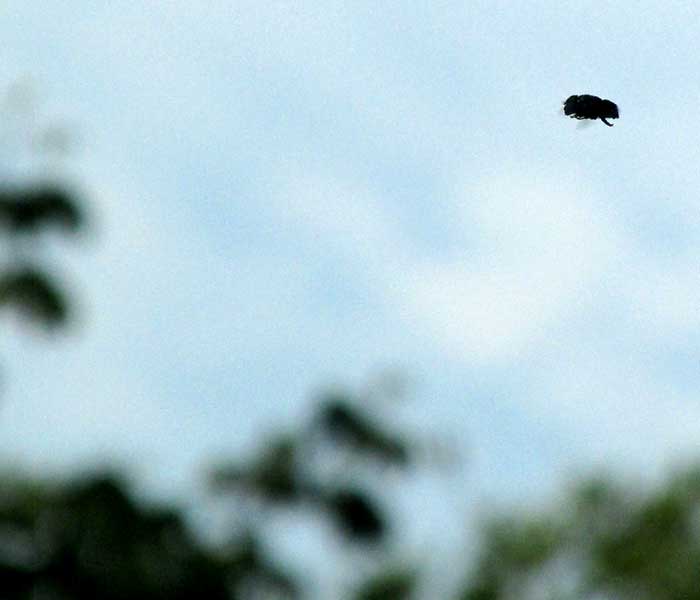Excerpts from Jim Conrad's
Naturalist Newsletter
from the August 22, 2010 Newsletter issued from Hacienda Chichen Resort beside Chichén Itzá Ruins, central Yucatán, MÉXICO; limestone bedrock, elevation ~39m (~128ft), ~N20.676°, ~W88.569°
THREE FLIES OVER THE COMPOST HEAP
I keep a compost heap going so I can throw banana peelings there and pee on it. About once a week I add a bucket of dry leaves because the heap decomposes so fast it'd otherwise disappear. During the first few days of the heap's existence the pee smelled a bit, but soon the mound developed a microbial population especially rich in microbes that convert pee's urea and uric acid to ammonia and other less smelly forms of nitrogen. In my microbiologically balanced compost heap the uric acid doesn't hang around unconverted long enough to cause a stink.
So, last Monday right before dark I was standing peeing on the compost heap when I noticed that on the underside of a leaflet of Spondias mombin three plump, big-headed, greenish flies were doing what you can see below:

It looked like each was depositing a layer of white silk or foam over the leaflet's undersurface. My drawing close enough to take the picture didn't seem to upset them at all. I just left them there as darkness came on, planning to keep an eye on those white spots. In two days, here's what one spot looked like:

Apparently, instead of the white patch being a smooth layer of silk or foam, it consisted of hundreds of very tiny, close-packed eggs or cocoons. Moreover, most of the white, baglike items appear to be split open, as if the larvae, or maggots, already have emerged from them, or maybe something tore the developing larvae from their bags. I'm not really sure what's going on.
One thing for sure, though, is that the white spots were deposited only on leaves about six feet (1.8 m) directly above the compost heap -- and not on any other leaves I could find. It looked to me as if the flies had left their eggs exactly where emerging offspring would fall through open air onto my compost heap with all its semi-decayed banana peelings, leaves and pee derivatives.
Volunteer bug identifier Bea in Ontario identified the flies as Green Hover Flies, ORNIDIA OBESA, described as a ubiquitous fly of the New World tropics. Apparently in earlier years when animal waste and garbage was less hygienically managed the species was much more common than it is now, even occurring in the southern half of the US. The maggots seem flexible in their food sources, being found in everything from the semiliquid stuff pooled in human outdoor toilets, to decaying fruit. One study showed that Green Hover Fly maggots can convert coffee-production waste into a protein-rich material useful in cattle feed.
When Bea sent me her ID, at first I wasn't sure she was right because the first Green Hover Fly image I Googled up showed the fly's two large compound eyes touching one another along most of their common sides. But you can see in our picture that our flies' eyes are widely separated. Googling more pictures I found that about half the flies shown had joined eyes while half were widely separated like ours.
Finally I remembered that in horseflies the males have contiguous eyes while the females have widely separated ones. It turns out that it's the very same with Green Hover Flies.
And that's interesting, since horseflies and hover flies aren't very closely related. A good guess is that the feature evolved independently in the two species. So what is there that makes widely spaced compound eyes more adaptive for the females of certain large fly species than for males?
Issued June 1, 2020 from the forest just west of Tepakán; elev. ~9m (~30 ft), N21.053°, W89.052°; north-central Yucatán state, MÉXICO
HOVERING
Throughout the year, especially during the mornings, you're likely to see one or more fairly large, heavy-bodied, big-headed, metallic-green flies like the one below hovering in one spot over open areas such as the concrete floor of the outside kitchen, or the hut's flattish roof.

Usually they're 3 to 10ft above the floor or roof. They bob hardly at all as they hover, but every ten or 20 seconds or so they explosively dart off as if chasing something, then quickly return to their previous coordinates in empty space, or maybe they'll change location a little, or a lot.
I'm fairly sure that we have the commonly occurring Green Hover Fly, because I've documented that species before, nicely shown (at rest) and described above.
Green Hover Flies are mimics of very unrelated orchid bees. Female orchid bees have stingers, and flies don't, so that explains why a fly might find it adaptive to look like a bee. A very nice article on the Green Hover Fly's mimicry is at http://gilwizen.com/ornidia/.